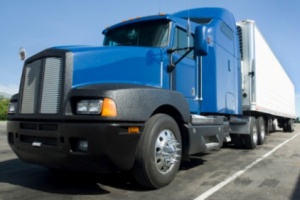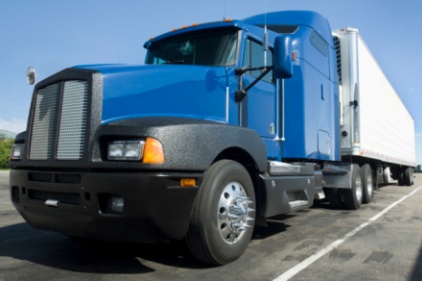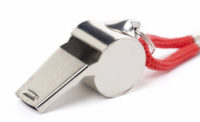 A “Quick Tips Technical Resources” article from W.W.Grainger’s safety staff. www.grainger.com
A “Quick Tips Technical Resources” article from W.W.Grainger’s safety staff. www.grainger.com
The rules and regulations regarding standard safe loading practices of enclosed and flatbed type of trailers for semi-tractor service is extensively covered in truck driver training schools.
Current information can also be found on the website of several different agencies involved with the trucking industry. (See Sources)
The following are several topics for concern:
Selection of binding chains: (49CFR 393.102)
Truckers frequently use chains to tie down their loads securely, to enhance safety and abide by the law. There are two important factors to keep in mind when evaluating chains:
The word "grade" describes the type of chain. For example, a "Grade 7" chain is popular with many carriers, despite its higher expense. It is a strong chain specifically for load securement, made from heat-treated carbon steel with a boron additive. "Grade 8" and "Grade 10" chains are made of alloy steel designed for heavy lifting.
The "safety factor" of chains refers to a fraction of maximum load weight that the chain can carry before breaking. If a chain can hold 1,000 pounds before breaking, and has a safety factor of 4, the chain would have a working load limit of 250 pounds (250=1/4 of 1000).
Truckers are required to use chains with a "working load limit" equal to 1/2 times the weight of the load (49CFR 393.102b).
In the example above, using a chain that has a working load limit of 250 pounds, truckers would need one chain for every 500 lbs.
The ATA (American Trucking Association) has asked the National Association of Chain Manufacturers to change the way it rates certain chains used for load securement. This change will encourage companies to use stronger chains to tie down loads.
Tiedowns: Ratchet -vs- Lock Binders: (49CFR 393.102)
The regulations from the U.S. Federal Motor Carrier Safety Regulations (FMCSR) state there must be one tie-down every 10 feet for general cargo and every eight feet for metal cargo. There must be enough tie downs so that when combined their working load limit equals half the weight of the cargo secured. At least two tie-downs must be used in securing metal articles.
Selection of Ratchet or Lock Binders is not specified and left to the user's discretion and preferences.
The present regulations from the U.S. Federal Motor Carrier Safety Regulations (FMCSR) state in the 2nd paragraph of 3.7.1 that vehicles that weigh over 10,000 pounds must be loaded accordingly to the provisions in section 3.8 which applies to heavy vehicles, equipment and machinery.
There is no mention of saddle mounts to haul large trucks and an effort is underway by the American Trucking Association (ATA) to get this included into the FMCSR standard.
Commonly Asked Questions
What guideline can I use in selecting chains to secure and tie down my loads?
The American Trucking Association (ATA), Commercial Vehicle Safety Alliance (CVSA), and Federal Highway Administration (FHWA) all offer information to help you with cargo safety standards. Refer to the websites listed at the end of this document.
Where can I get the latest news on trucking regulations and hazards?
The American Trucking Association(ATA).
How can I avoid costly violations of safety rules?
By obtaining training through safety seminars such as that offered by The Commercial Vehicle Safety Alliance (CVSA).
Sources
Title 49—Transportation, 49CFR 393, Subparts A—General, and I—Protection Against Shifting Cargo.
http://www.gpo.gov/fdsys/pkg/CFR-2010-title49-vol5/xml/CFR-2010-title49-vol5-part393.xml
ATA (American Trucking Association) For latest information on current events, news, laws, safety features, and regulatory issues.
www.truckline.com
FMCSR (US Federal Motor Carrier Safety Regulations) www.fmcsa.dot.gov. Trucking Industry news, education, outreach, issues.
CVSA (Commercial Vehicle Safety Alliance) www.cvsa.org. Topics and reference on motor carrier, vehicle, cargo safety standards, compliance, education and enforcement.
FHWA (Federal Highway Administration) interpretations and guidance on safety and regulatory issues. www.fhwa.dot.gov
Trucking Safety Transportation Services. www.stsny.com
(Rev. 1/2012)
Find even more information you can use to help make informed decisions about the regulatory issues you face in your workplace every day. View all Quick Tips Technical Resources at www.grainger.com/quicktips.
Think Safety. Think Grainger.®
Grainger has the products, services and resources to help keep employees safe and healthy while operating safer facilities. You’ll also find a network of safety resources that help you stay in compliance and protect employees from hazardous situations. Count on Grainger for lockout tagout, fall protection equipment, confined space products, safety signs, personal protective equipment (PPE), emergency response and so much more.
Please Note:
The content in this article is intended for general information purposes only. This publication is not a substitute for review of the applicable government regulations and standards, and should not be construed as legal advice or opinion. Readers with specific compliance questions should refer to the cited regulation or consult with an attorney.


